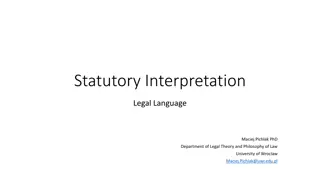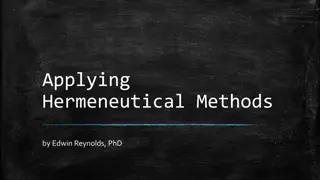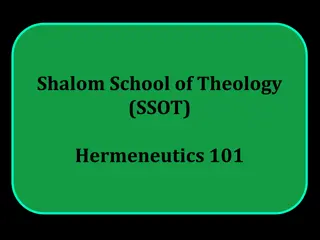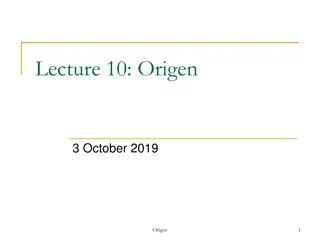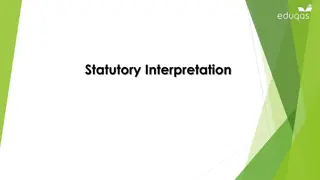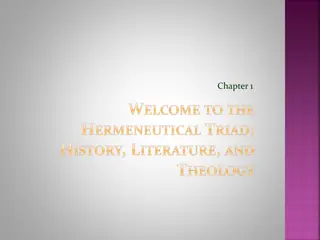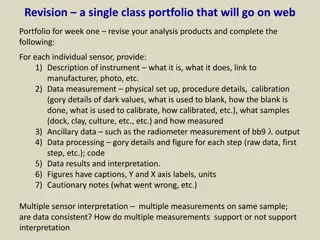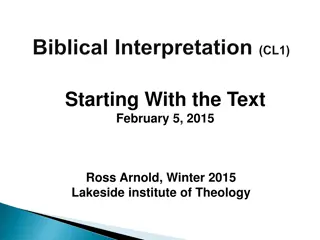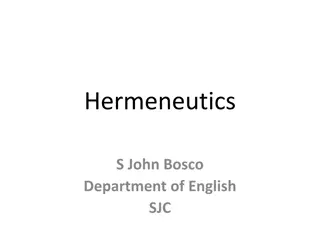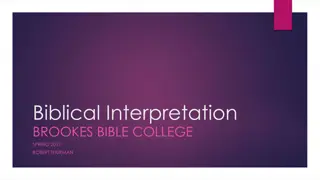Hermeneutics in Biblical Interpretation
Hermeneutics is the discipline of interpreting communication, specifically texts, providing the principles for recognizing meaning in the Bible. Key issues include determining the number of meanings, authorial intent, reader response, exegesis versus eisegesis. Various hermeneutic models exist, prompting the question of which to choose and why. Systematic theology plays a role in guiding the interpretation process.
Download Presentation

Please find below an Image/Link to download the presentation.
The content on the website is provided AS IS for your information and personal use only. It may not be sold, licensed, or shared on other websites without obtaining consent from the author.If you encounter any issues during the download, it is possible that the publisher has removed the file from their server.
You are allowed to download the files provided on this website for personal or commercial use, subject to the condition that they are used lawfully. All files are the property of their respective owners.
The content on the website is provided AS IS for your information and personal use only. It may not be sold, licensed, or shared on other websites without obtaining consent from the author.
E N D
Presentation Transcript
SOLA SCRIPTURA SOLA SCRIPTURA HOW TO UNDERSTAND HOW TO UNDERSTAND AND USE THE BIBLE AND USE THE BIBLE Christopher Cone, Th.D, Ph.D, Ph.D www.drcone.com www.agathonedu.com
WHAT IS WHAT IS HERMENEUTICS? HERMENEUTICS?
Definition Definition Hermeneutics is the discipline of interpreting communication (texts specifically). Hermeneutics provides the principles for recognizing meaning. Where there is communication, there is interpretation.
Key Issues Key Issues How many meanings are there? Who determines the meaning? Reader response Authorial intent Exegesis vs. Eisegesis
Hermeneutic Models Hermeneutic Models Theological Allegorical Spiritualization Genre Trajectory/Postmodern/Cultural Complementary/Canonical Dogmatic Literal Grammatical Historical
WHICH SHALL WE CHOOSE AND WHY?
Without a systematic theology how can you begin to know what to do with the eschatology of Ezekiel or the sacramental language in John 6 or the psalmist s insistence that he is righteous and blameless? As a Christian I hope that my theology is open to correction, but as a minister I have to start somewhere. We all do. For me that means somewhere. We all do. For me that means starting with Reformed theology and my starting with Reformed theology and my confessional tradition and sticking with that confessional tradition and sticking with that unless I have really good reason not to. Kevin DeYoung https://blogs.thegospelcoalition.org/kevindeyoung/2012/02/2 3/your-theological-system-should-tell-you-how-to-exegete/ I have to start
20But know this first of all, that no prophecy of Scripture is a matter of one s own interpretation, 21 for no prophecy was ever made by an act of human will, but men moved by the Holy Spirit spoke from God. 2 Peter 1:20-21.
On What Basis to Choose? On What Basis to Choose? Presuppositions External data needed? External data not needed? Internal modeling Internal modeling over external prescription How does the text model how to understand the text? Who determines meaning? Reader response Authorial intent
Does the Bible Show Us How to Does the Bible Show Us How to Interpret the Bible? Interpret the Bible? The Genesis Model: Theological Interpretation? Literal Grammatical Historical?
So What? Any departure from Literal Grammatical Historical requires explicit exegetical support for any change in method Hermeneutic methodology for understanding Scripture is not arbitrary but is instead plainly modeled. Later Scriptures should be understood in light of the hermeneutic precedent provided by Genesis. 6 Basic Rules 4 Basic Steps
6 Basic Rules 6 Basic Rules Literal 1. Recognize normal, natural sense, how we read any basic communication Grammatical Historical 2. Recognize historical setting 3. Recognize original language and rules of grammar 4. Recognize context 5. Recognize Author s intent 6. Recognize progress in the writing
4 Basic Steps of Bible Study 4 Basic Steps of Bible Study (the scientific method) (the scientific method) Observe Interpret Verify Apply
Helpful Tools Helpful Tools Bible (formal equivalence vs. dynamic equivalence) Concordance Bible Dictionary Lexicon Notes/Commentaries (e.g., Constable s Notes, soniclight.com) Bible software (esword, logos, accordance, Bibleworks, websites) Commitment
Applying the Bible In Living Recognize primary application Identify principles Recognize secondary application In Communicating Develop exposition (preaching, teaching) The fishing principle
Applying the Bible In Living Recognize primary application Identify principles Recognize secondary application In Communicating Develop exposition (preaching, teaching) The fishing principle



